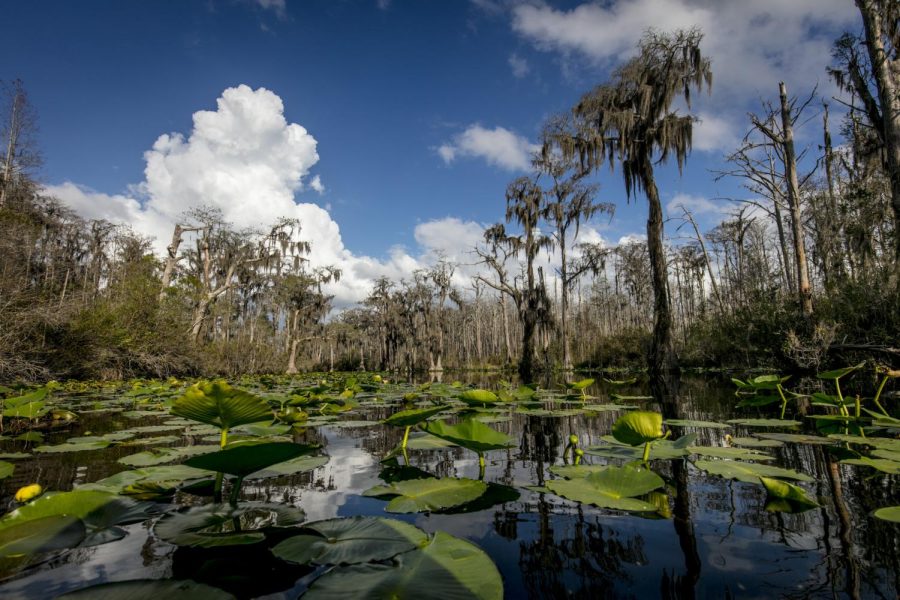The Okefenokee Experience seeks to save the swamp
The strip mine that Twin Pines Minerals is selling a permit for would damage the diverse ecosystem of the Okefenokee swamp.
April 4, 2023
The Okefenokee Swamp is a natural wonder, filled with thousands of species of wildlife. Though crucial to Georgia’s many ecosystems, this rich biodiversity source may be at risk.
Twin Pines Minerals, a mining company based in Alabama, is attempting to gain a permit that would allow the organization to mine in areas near the Okefenokee. However, a combined effort of community engagement and movements led by the Okefenokee Experience Project has contested this and aims to save the swamp from destruction.
“The Swamp is a magical place, and it’s different every time you visit it,” Bill Sapp, the chair of the Okefenokee Protection Alliance said. “When I think of the swamp, I think of it as a place where you can just totally get away from your regular life and experience the outdoors in a way you can’t experience anywhere else.”
Twin Pines Minerals has proposed an 8,000-acre strip mine, part of which is only 400 feet from the Okefenokee. This region is the Trail Ridge, a mineral-rich area of land along the border of the swamp. The purpose of this strip mine would be to extract titanium dioxide, which is used in whitening products such as toothpaste and white paint.
“The mining will damage the water system of the Okefenokee by changing the water level and hydrology of the swamp, damaging valuable habitats for aquatic and amphibious animals as well as plant life,” senior Simon Taylor, a lobbyist for the prevention of the mine, said.
Because the mining of heavy minerals puts the habitat of the Okefenokee Swamp in jeopardy, members of the community such as Taylor and Sapp are advocating to put a stop to the project.
“The mission of the [Okefenokee Protection] alliance is to protect the Okefenokee for this generation and future generations,” Sapp said. “Now, what we have been doing is raising awareness about this threat to the Okefenokee and making sure that people know that if this mine were to be permitted, it could have a significant adverse effect on the swamp.”
As thousands of people visit the swamp every year, Kim Bednarek wishes to increase visitors and in turn advocate against the mining project. To do so, he organized the Okefenokee Experience which is inspired by The Wild Center in the Adirondack mountains. It consists of three centers: the nature center, cultural history center and an observatory.
“The Okefenokee Experience Project is a series of three exhibits; I would say three distinct experiences,” Bednarek said. “We have three gateway communities, and the idea of the experience is to have very explicit distinct educational, cultural and immersive experiences at each entrance.”
These centers will aim to bring economic prosperity to the Okefenokee Swamp region through new jobs in these businesses and ecotourism.
“What we’re doing is trying to emphasize to anyone and everyone, particularly in the community and in this state, is that if you invest in the businesses that are already thriving, which are associated with ecotourism, recreation and education, then that’s a way to ensure that people want to conserve, preserve and celebrate the Okefenokee,” Bednarek said.
The Okefenokee Experience is still in the planning stages, consisting of architectural renderings, stakeholder meetings and community charrettes. With proper funding, Bednarek predicts construction will begin in 2024 or 2025.
“It would be setting up just an amazing opportunity for people and students from all over the state to really learn about this natural resource and also learn about the dark skies down there,” Sapp said.
Despite the impact this project is projected to have, members of the community are taking immediate action to stop the destructive mining project.
“I am advocating this issue by trying to raise awareness – because most people don’t really know much about it in Atlanta – and also letting people know that they can donate to different lobbying funds,” Taylor said.
Taylor has spoken to Georgia senators about the issue and is planning on visiting the swamp to see the issue in person while learning more about ways he can help.
“I encourage others to take a dive into this issue as soon as possible because we are running out of time,” Taylor said. “Emailing and sending letters to our state congresspeople will help prevent Twin Pines from encroaching on the environmental rights of southern Georgia.”
Because of the swamp’s 400,000 acres of pristine wetland filled with an immense variety of vegetation and wildlife, it is under consideration to receive World Heritage Site status by the World Heritage Committee. Areas with this status are defined as having outstanding universal value to humanity. Other areas with World Heritage site status include the Taj Mahal, the Great Barrier Reef, the Galápagos Islands and the pyramids of Egypt.
Sapp said the proposal for World Heritage Site status would bring even more people to the swamp area.
“If the Okefenokee Swamp is visited by tourists and scientists and students from around the world, and if it was adversely impacted by this mine, it would rob those people of an experience they just can’t get anywhere else,” Sapp said.
Both Sapp and Bednarek believe the Okefenokee is an integral part of the Georgian landscape, and if it was adversely impacted by the mine, people throughout the world would be affected due to the swamp’s importance to the environment
“The Okefenokee is an outstanding place for humans to interact, enjoy a peaceful wilderness setting and experience an unparalleled dark sky,” Bednarek said. “There’s not a lot of places left like the Okefenokee.”







